Five Whys is an effective problem-solving approach that constitutes a questioning process designed to drill down into the details of a problem and peel away the layers of symptoms.
The technique was originally developed by Sakichi Toyoda and was used during the evolution of manufacturing methodologies at Toyota Motor Corporation. It is a critical component of problem-solving training, delivered as part of the induction into the Toyota Production System.[1], [2]
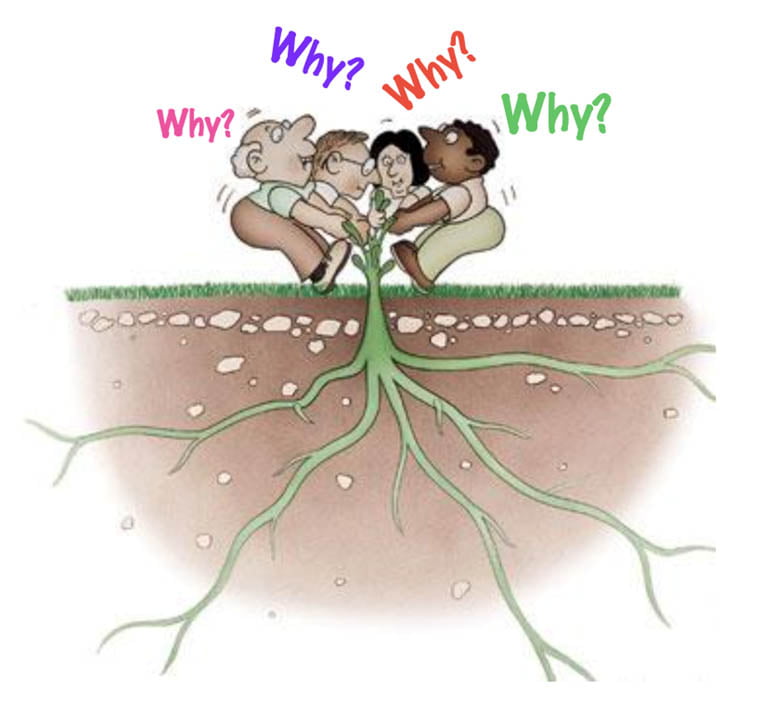
5 Whys analysis can be used to develop a better and more detailed understanding of the problem, to implement solutions that don’t just address the symptoms but have a lasting, more permanent impact and to get to the Root Cause.
Rationale
The technique works on the premise that for every effect, there is a root cause, but the resulting chain between the two can be fairly long and difficult to establish. When a problem appears, the temptation is strong to blame it on what is easily evident while ignoring the hidden root cause(s).
This tendency frequently results in suboptimal or temporary solutions, and the problem resurfaces shortly after.
Five Whys works by providing a simple question-asking technique that explores the cause-and-effect relationships and the underlying problems.
There are three key elements to effective use of the Five Whys technique:
- Accurate and complete problem statement
- Honesty in answering the questions
- The determination to get to the bottom of the problem
How to Use the Five Whys Technique
The Five Whys technique promotes deep thinking through questioning and can be applied to most problems. It is more effective when used in a team (preferably cross-functional) and has five basic steps:
1. Forming the Team and defining the problem statement
Gather the team and develop the problem statement in agreement. Decide whether additional individuals are needed to resolve the problem.
It is important to involve those responsible for the process and those who carried out the activity that presented the problem. Including individuals with varied experiences brings unique viewpoints, leading to effective analysis.
The specific problem must then be written down as it helps formalize the issue and ensures team focus. The problem statement must describe the current condition as it is known and not as it “could be” or “thought to be”.
The situation must be supported by data wherever possible, for example: “Overall customer complaints are up 50%”.
Data may come from reports, staff or stakeholder qualitative surveys, experiences, or by observing the problem occurring in multiple situations while taking notes.
2. Asking the first Why
Answering why requires genuine thought. As far as possible, teams must stick to answers that are based on facts: there must be records of events that have happened, not guesses at what might have occurred.
Asking the first “why” could generate three or four sensible answers. They must then be recorded on a flip chart or whiteboard.
3. Successive Whys
The team then continues asking more (typically four) successive “whys,” repeating the process for every statement on the flip chart or whiteboard.
Answers to each of these ‘whys’ must be posted near its “parent.”
All plausible answers must then be followed up. Eventually, the team will reach a point where there are no more “Whys” and the question that remains is the root cause.
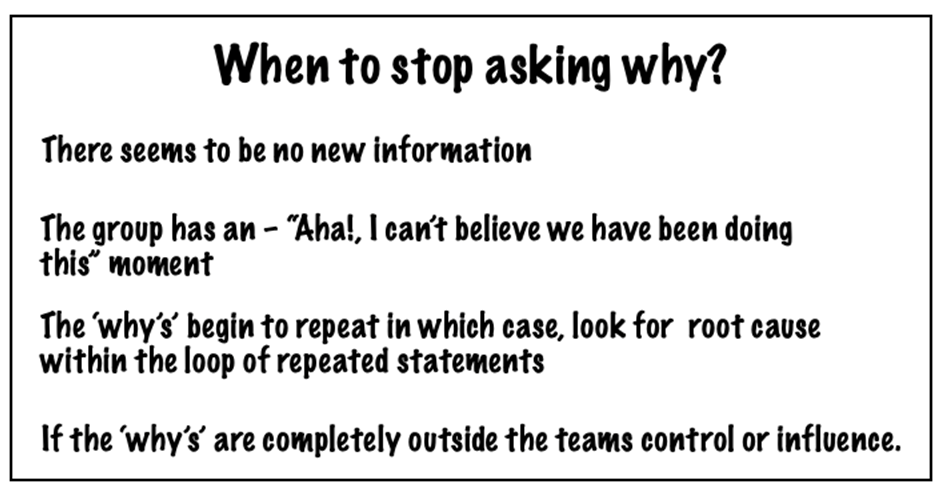
The team will know they have arrived at the root cause when asking “why” yields no further useful information. (The team might need to continue to ask questions beyond the arbitrary five layers to get to the root cause)
4. Look for systemic causes
Among the dozen or so answers to the last asked “why”, look for systemic causes of the problem. Discuss these and settle on the most likely systemic cause.
Follow the team session with a debriefing and show the results to others to confirm that they see logic in the analysis.
5. Develop Corrective action
After settling on the most probable root cause of the problem and obtaining confirmation of the logic behind the analysis, develop appropriate corrective actions to remove the root cause from the system. The actions can (as the case demands) be undertaken by others but planning and implementation will benefit from team inputs.
Five Whys – Working Templates
Teams can make use of the below worksheet while conducting the Five Whys Analysis:
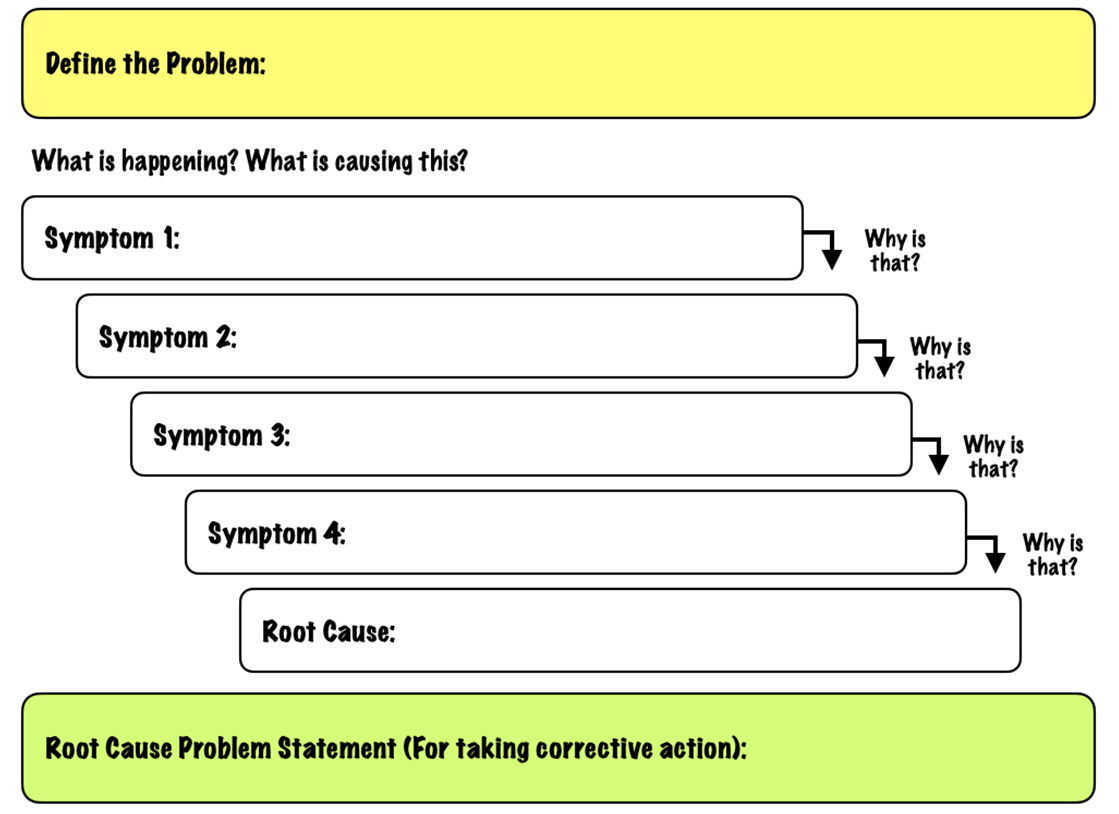
In some cases, there could be more than one root cause, in which case, the analysis will follow the “Why Tree Framework” as shown:
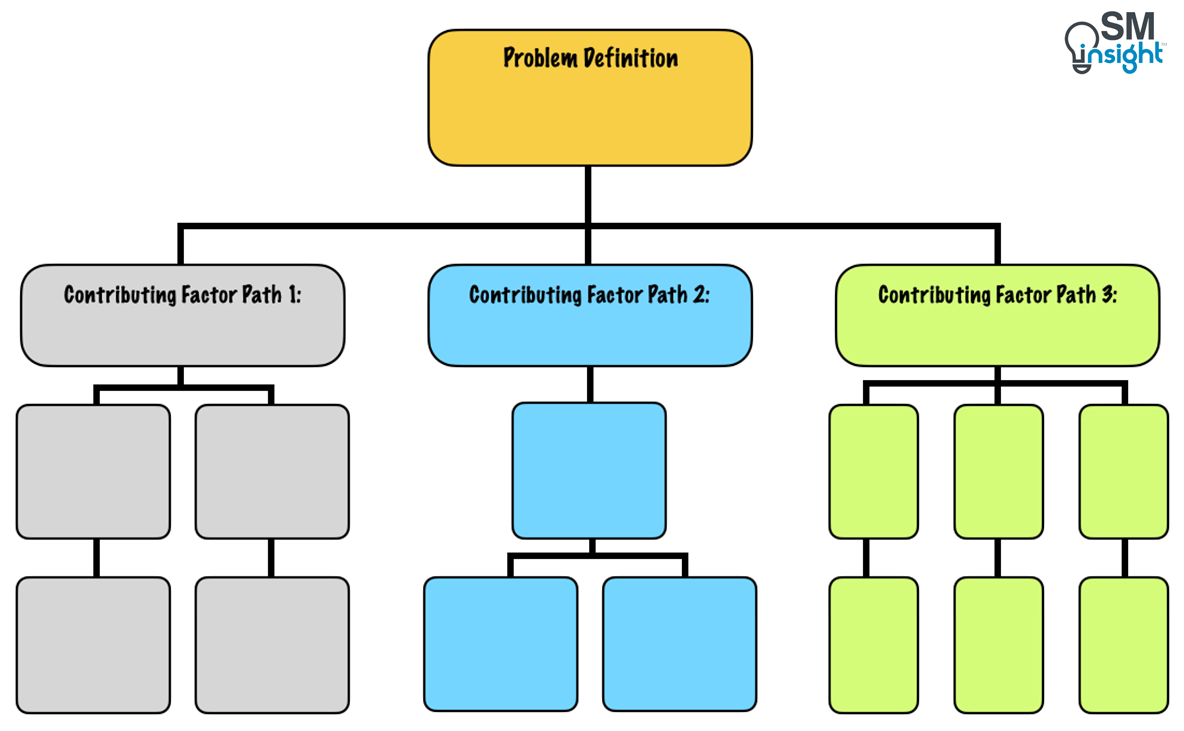
Example of Five Whys Analysis
Five Whys Analysis is a flexible tool and can be applied to varied situations and conditions, from manufacturing to business to organization design. Some of the example applications are as follows:
Five Whys in Manufacturing
Suppose a machine in an assembly line has stopped functioning. Five Whys analysis of the situation would proceed as follows:
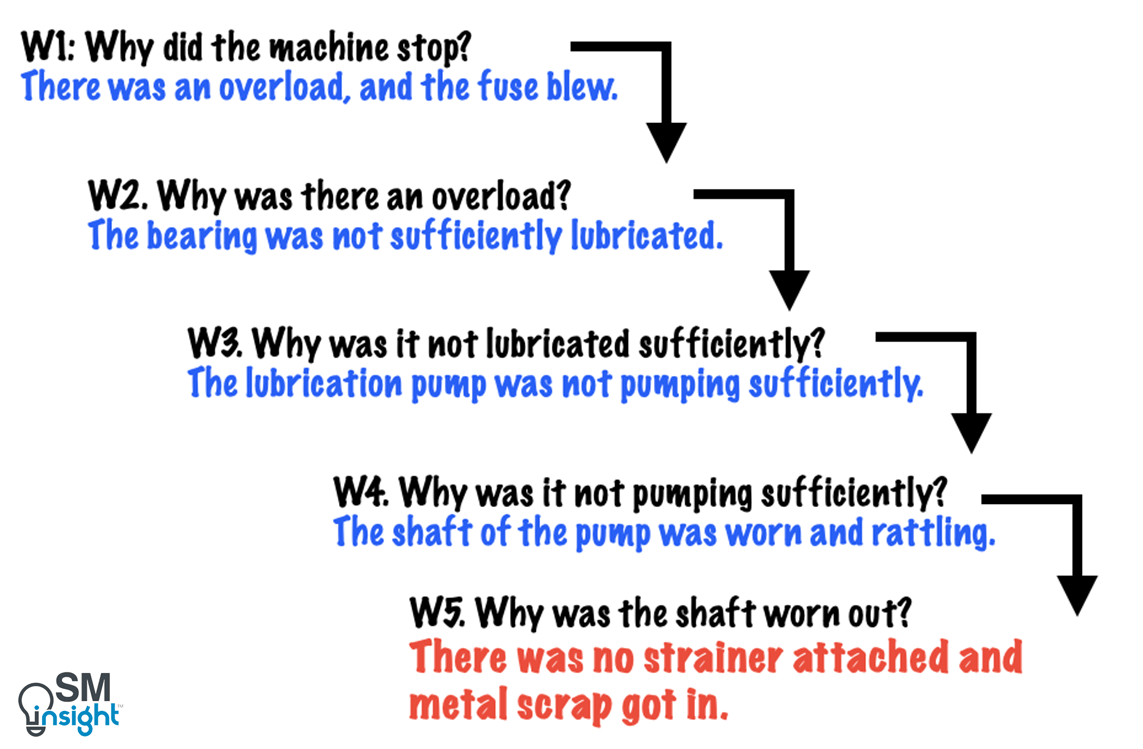
The example demonstrates how repeating why five times helps uncover the root problem and thus correct it. If this procedure were not carried out, one could simply replace the fuse or the pump shaft. In such case, the problem would recur within a few months, or in the worst case cause permanent damage.
Five Whys in Diagnosing System Usage
The Harford County Health Department (HCHD) noticed very low usage of a newly introduced translation service meant to help the Limited English Proficiency (LEP) populations residing in the County.
HCHD decided to perform a Five Whys analysis to understand the underlying reasons. The resulting analysis is as shown:
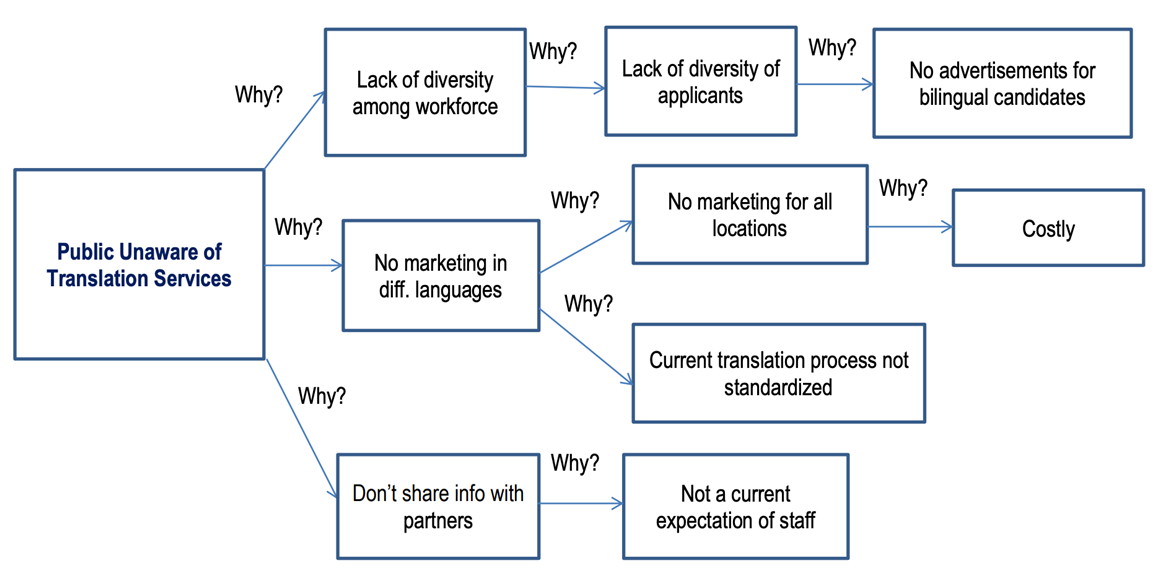
It can be seen how the analysis reveals more than one branch of causes and drills down to the fundamental reasons.
5-Whys Criticisms
Five Whys has been criticized as a poor tool for root cause analysis. Its critics include Teruyuki Minoura, former managing director of global purchasing for Toyota[7] and Medical professor Alan J. Card.[8]
Some of the reasons for this criticism are:
- The tendency to stop at symptoms rather than going on to lower-level root causes.
- Inability to go beyond the investigator’s current knowledge.
- Lack of support to help the investigator provide the right answer to “why” questions.
- Results may not be repeatable – different people may come up with different causes.
- Tendency to isolate a single root cause, whereas each question could have many different root causes.
However, in his article[9], author, Mark Galley defends the tool and concludes that while Five Whys is not a complete method, it helps bring structure, clarity, and simplicity to problem-solving.
Sources
1. “Toyota Production System”. Toyota, https://global.toyota/en/company/vision-and-philosophy/production-system/. Accessed 26 Aug 2023
2. “Toyota Production System: Beyond Large-Scale Production”. Taiichi Ohno, https://www.amazon.com/dp/B0B3FY1MT5?ref_=cm_sw_r_cp_ud_dp_799G30M0SS0RW9ANSEH4. Accessed 27 Aug 2023
3. “The 5 Whys – What is it?”. County of Los Angeles Public Health, http://publichealth.lacounty.gov/qiap/docs/Topic3-Fishbone.pdf. Accessed 27 Aug 2023
4. “5 Whys Exercise”. University of Wisconsin, https://media.wcwpds.wisc.edu/PDSA%20Online%20Toolkit/Plan_Problem%20Exploration_Test%20Selection/5%20Whys%20Exercise.pdf. Accessed 27 Aug 2023
5. “The Five Whys Technique”. Olivier Serrat (Asian Development Bank), https://www.adb.org/sites/default/files/publication/27641/five-whys-technique.pdf. Accessed 27 Aug 2023
6. “Improving Communication with Limited English Proficiency (LEP) Populations”. Harford County Health Department, http://publichealth.lacounty.gov/qiap/docs/Topic3-StoryboardWhys.pdf. Accessed 28 Aug 2023
7. “THE “THINKING” PRODUCTION SYSTEM: TPS AS A WINNING STRATEGY FOR DEVELOPING PEOPLE IN THE GLOBAL MANUFACTURING ENVIRONMENT”. Toyota, https://web.archive.org/web/20201121032113/https://media.toyota.co.uk/wp-content/files_mf/1323862732essenceTPS.pdf. Accessed 28 Aug 2023
8. “The problem with ‘5 whys’”. Dr Alan J Card, https://qualitysafety.bmj.com/content/26/8/671. Accessed 28 Aug 2023
9. “What the critics don’t understand”. Mark Galley, https://blog.thinkreliability.com/top-criticisms-of-the-5-why-approach. Accessed 28 Aug 2023

